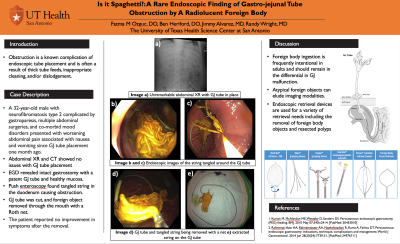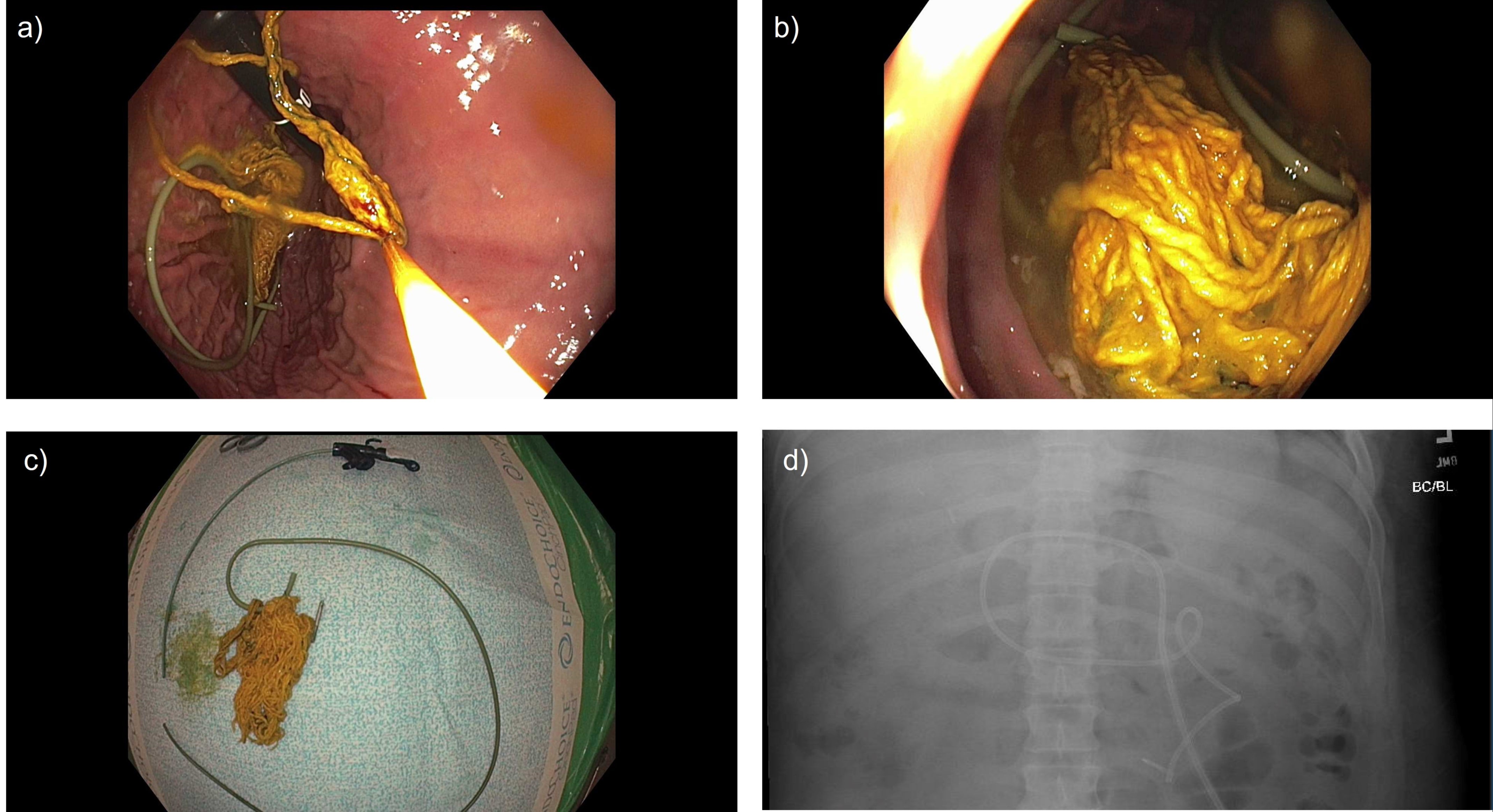Tuesday Poster Session
Category: General Endoscopy
P3434 - Is It Spaghetti?: A Rare Endoscopic Finding of Gastro-Jejunal Tube Obstruction by a Radiolucent Foreign Body
Tuesday, October 24, 2023
10:30 AM - 4:00 PM PT
Location: Exhibit Hall

Has Audio

Fatma Ozguc, DO
UTHSCSA
San Antonio, TX
Presenting Author(s)
Fatma Ozguc, DO1, Benjamin Heriford, DO2, James Alvarez, MD3, Randy Wright, MD2
1UTHSCSA, San Antonio, TX; 2University of Texas Health Science Center at San Antonio, San Antonio, TX; 3University of Texas Health Science Center-San Antonio, San Antonio, TX
Introduction: Obstruction is a known complication of endoscopic tube placement and is often a result of thick tube feeds, inappropriate cleaning, and/or dislodgement. We present a unique case of gastro-jejunal (GJ) tube blockage from a ball of strings in a patient with co-morbid mood disorders.
Case Description/Methods: A 32-year-old male with past medical history of neurofibromatosis type 2 complicated by gastroparesis and multiple abdominal surgeries presented to the emergency department with worsening abdominal pain associated with nausea and vomiting since GJ tube placement for reported gastroparesis one month ago. An abdominal XR was unremarkable. The GJ tube appeared well-positioned on CT of the abdomen with suspected fracturing of the distal tip of the GJ tube contained within the jejunal lumen, which was presumed to be the clip. Esophagogastroduodenoscopy (EGD) revealed an intact gastrostomy with a patent GJ tube present with healthy appearing mucosa and there was no evidence of a buried bumper syndrome. Push enteroscopy demonstrated tangled string in the duodenum that served as a probable cause of his obstructive symptoms. The GJ tube was subsequently cut, and foreign object removed through the mouth with the Roth net without complications. The patient reported no improvement in symptoms and no explanation for the foreign object. The patient was diagnosed with functional abdominal pain syndrome and visceral hyperalgesia.
Discussion: Endoscopic tubes can often be blocked and become non-functional due to inadequate cleaning, feeds, or foreign body ingestion. Foreign body ingestion is frequently intentional in adults and should remain in the differential in GJ malfunction especially in patients with comorbid mood disorders. In this case, the patient’s initial symptoms were attributed to his gastroparesis. The initial abdominal XR was unremarkable as the string was radiolucent and CT scan additionally failed to visualize the object. This initially lowered foreign body ingestion on the differential as there were other explanations. The GJ tube and tangled string were removed through the mouth with a net. This case highlights the importance of keeping foreign body obstruction in the differential in patients with mood disorders as atypical foreign objects can elude imaging modalities.

Disclosures:
Fatma Ozguc, DO1, Benjamin Heriford, DO2, James Alvarez, MD3, Randy Wright, MD2. P3434 - Is It Spaghetti?: A Rare Endoscopic Finding of Gastro-Jejunal Tube Obstruction by a Radiolucent Foreign Body, ACG 2023 Annual Scientific Meeting Abstracts. Vancouver, BC, Canada: American College of Gastroenterology.
1UTHSCSA, San Antonio, TX; 2University of Texas Health Science Center at San Antonio, San Antonio, TX; 3University of Texas Health Science Center-San Antonio, San Antonio, TX
Introduction: Obstruction is a known complication of endoscopic tube placement and is often a result of thick tube feeds, inappropriate cleaning, and/or dislodgement. We present a unique case of gastro-jejunal (GJ) tube blockage from a ball of strings in a patient with co-morbid mood disorders.
Case Description/Methods: A 32-year-old male with past medical history of neurofibromatosis type 2 complicated by gastroparesis and multiple abdominal surgeries presented to the emergency department with worsening abdominal pain associated with nausea and vomiting since GJ tube placement for reported gastroparesis one month ago. An abdominal XR was unremarkable. The GJ tube appeared well-positioned on CT of the abdomen with suspected fracturing of the distal tip of the GJ tube contained within the jejunal lumen, which was presumed to be the clip. Esophagogastroduodenoscopy (EGD) revealed an intact gastrostomy with a patent GJ tube present with healthy appearing mucosa and there was no evidence of a buried bumper syndrome. Push enteroscopy demonstrated tangled string in the duodenum that served as a probable cause of his obstructive symptoms. The GJ tube was subsequently cut, and foreign object removed through the mouth with the Roth net without complications. The patient reported no improvement in symptoms and no explanation for the foreign object. The patient was diagnosed with functional abdominal pain syndrome and visceral hyperalgesia.
Discussion: Endoscopic tubes can often be blocked and become non-functional due to inadequate cleaning, feeds, or foreign body ingestion. Foreign body ingestion is frequently intentional in adults and should remain in the differential in GJ malfunction especially in patients with comorbid mood disorders. In this case, the patient’s initial symptoms were attributed to his gastroparesis. The initial abdominal XR was unremarkable as the string was radiolucent and CT scan additionally failed to visualize the object. This initially lowered foreign body ingestion on the differential as there were other explanations. The GJ tube and tangled string were removed through the mouth with a net. This case highlights the importance of keeping foreign body obstruction in the differential in patients with mood disorders as atypical foreign objects can elude imaging modalities.

Figure: Panel a) and b): endoscopic images of the string tangled around the GJ tube. Panel c): extracted string on the GJ tube. Panel d): unremarkable abdominal Xray with GJ tube in place
Disclosures:
Fatma Ozguc indicated no relevant financial relationships.
Benjamin Heriford indicated no relevant financial relationships.
James Alvarez indicated no relevant financial relationships.
Randy Wright indicated no relevant financial relationships.
Fatma Ozguc, DO1, Benjamin Heriford, DO2, James Alvarez, MD3, Randy Wright, MD2. P3434 - Is It Spaghetti?: A Rare Endoscopic Finding of Gastro-Jejunal Tube Obstruction by a Radiolucent Foreign Body, ACG 2023 Annual Scientific Meeting Abstracts. Vancouver, BC, Canada: American College of Gastroenterology.
